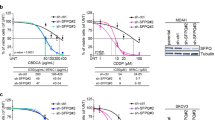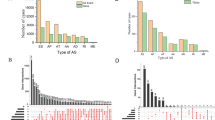Abstract
Cisplatin is the most commonly used chemotherapeutic agent in the treatment of ovarian cancer. One of the mechanisms of resistance of ovarian tumours to cisplatin is increased nucleotide excision repair activity, in particular increased levels of the endonuclease ERCC1. Since 30–40% of ovarian cancers develop resistance to cisplatin after treatment and these tumours are usually incurable, ERCC1 expression is potentially useful as a predictive marker for the effectiveness of cisplatin-based chemotherapy. Using RT–PCR and Northern blotting, we have examined the expression of a 42 bp differentially spliced sequence in exon 1 of the human ERCC1 gene, loss of which has previously been reported to be correlated with higher levels of ERCC1 mRNA in ovarian cancer cell lines. We report here that this alternate transcript is ubiquitous in human tissues and cancer cell lines, is absent in mouse and thus does not appear to be cancer related.
This is a preview of subscription content, access via your institution
Access options
Subscribe to this journal
Receive 50 print issues and online access
$259.00 per year
only $5.18 per issue
Buy this article
- Purchase on Springer Link
- Instant access to full article PDF
Prices may be subject to local taxes which are calculated during checkout


Similar content being viewed by others
References
Dabholkar M, Vionnet J, Bostick-Bruton F, Yu JJ and Reed E . (1994). J. Clin. Invest., 94, 703–708.
Damia G, Imperatori L, Stefanini M and D'Incalci M . (1996). Int. J. Cancer, 66, 779–783.
Ferry KV, Hamilton TC and Johnson SW . (2000). Biochem. Pharmacol., 60, 1305–1313.
Hoy CA, Thompson LH, Mooney CL and Salazar EP . (1985). Cancer Res., 45, 1737–1743.
Isla D, Sarries C, Rosell R, Alonso G, Domine M, Taron M, Lopez-Vivanco G, Camps C, Botia M, Nunez L, Sanchez-Ronco M, Sanchez JJ, Lopez-Brea M, Barneto I, Paredes A, Medina B, Artal A and Lianes P . (2004). Ann. Oncol., 15, 1194–1203.
Johnson SW, Perez RP, Godwin AK, Yeung AT, Handel LM, Ozols RF and Hamilton TC . (1994). Biochem. Pharmacol., 47, 689–697.
Langdon SP, Lawrie SS, Hay FG, Hawkes MM, McDonald A, Hayward IP, Schol DJ, Hilgers J, Leonard RC and Smyth JF . (1988). Cancer Res., 48, 6166–6172.
Li Q, Tsang B, Bostick-Bruton F and Reed E . (1999). Biochem. Pharmacol., 57, 347–353.
Li T, Song Y, Liang X, Guo Y, Reed E and Yu JJ . (2004). Int. J. Oncol., 25, 1105–1111.
Masuda H, Ozols RF, Lai GM, Fojo A, Rothenberg M and Hamilton TC . (1988). Cancer Res., 48, 5713–5716.
Masuda H, Tanaka T, Matsuda H and Kusaba I . (1990). Cancer Res., 50, 1863–1866.
McGuire WP and Ozols RF . (1998). Semin. Oncol., 25, 340–348.
Parker RJ, Eastman A, Bostick-Bruton F and Reed E . (1991). J. Clin Invest., 87, 772–777.
Ryu JS, Hong YC, Han HS, Lee JE, Kim S, Park YM, Kim YC and Hwang TS . (2004). Lung Cancer, 44, 311–316.
Stoehlmacher J, Park DJ, Zhang W, Yang D, Groshen S, Zahedy S and Lenz HJ . (2004). Br. J. Cancer, 91, 344–354.
Thompson S, Clarke AR, Pow AM, Hooper ML and Melton DW . (1989). Cell, 56, 313–321.
Yu JJ, Thornton K, Guo Y, Kotz H and Reed E . (2001). Oncogene, 20, 7694–7698.
Acknowledgements
We thank Dr Grant Sellar (Cancer Research UK Centre, University of Edinburgh) for kindly providing the ovarian cancer cell lines and Dr Scott Bader (Sir Alastair Currie Cancer Research UK Laboratories, University of Edinburgh) for HPRT primers. This work was supported by a programme grant (C376/A1570) from Cancer Research UK to DWM.
Author information
Authors and Affiliations
Corresponding author
Rights and permissions
About this article
Cite this article
Winter, A., Dorgan, C. & Melton, D. Expression of a splicing variant in the 5′-UTR of the human ERCC1 gene is not cancer related. Oncogene 24, 2110–2113 (2005). https://doi.org/10.1038/sj.onc.1208400
Received:
Revised:
Accepted:
Published:
Issue Date:
DOI: https://doi.org/10.1038/sj.onc.1208400



